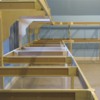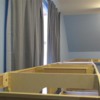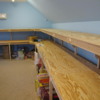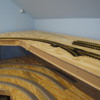Dear Cape Cod,
Many thanks for all the info and time. Greatly appreciated. First things: As you're close to Tim and Lynn (I talk to them always at York), maybe you can HELP ME TO SEE what the second levels look like. Tim says he has no pix nor video (you should urge him to post some). In fact--ironically--he urged me to go on the Forum and ask if anyone had any!
So far I've had much good and sincere advice, but I'm still no closer to seeing what it looks like, nor what height I might put the second level at, as Tim keeps asking me. I understand it's an independent second level which is fine. I was thinking of running 50s Marklin HO even just back and forth, or at least increasing my various villages real estate. Lighting: Do people put light strips under the shelf to counter-act the "cave" effect? I WOULD LOVE TO SEE ANY PIX OF THIS.
40x30 with 97 switches!! Amazing. I'm just aiming for a modest, no-grades, pre-war layout mainly to show all my houses, stations, villas, bungalows, lampposts, metal cars, 100s of people, etc. My idea is to recreate a period look with mirror lakes, even green sawdust grass, no concern for scale, like those I lusted over as a kid.
Celotex Sound Stop: Is it as good as Homa in absorbing sound? Where do you get it (H-D?)? (I will still use Homa on the floor as a sound proofer, but open to anything on the layout.)
CDX plywood: What is it? Why not a good grade regular 3/4 ply? I understand totally about no mechanical fasteners--screws, etc.--and what an evil conduit they'd be for sound.
Cork road bed: So no additional sound absorbing? But then what do you use to simulate the ballasted road bed? I liked the cork because it comes in a strip already scored, when you separate it the bevel's already there, and easily curved in its half-widths. However, as I've never done any of this, I'm more than ready to stand corrected by anyone.
Mianne: Are there any pointers or tips about designing with it, using it, assembling it, figuring out dimensions (for instance, Tim said that when he shows an aisle of 24 inches it's actually about 20 because of the bench work---but why is that??
Thanks again,
ron
Ron,
I started began purchasing my Mianne bench work some 14 years ago and my basement layout has now grown to 40'x30'. My wife and I have become good friends with Tim and Lynn and we can usually be found working their booth at York and Springfield. I am a huge fan of his product.
It appears that you have done some serious research before starting your project and are now seeking advice from forum members that have already established at least some of their layout.
Atop my Mianne bench work, I used 5/8" CDX plywood which is screwed to the bench work. Atop that I used a product by Celotex called Sound Stop. It comes in a 4'x8' sheet, has a medium brown color and it is fibrous in texture. It is 1/2" thick, a lot lighter and 1/3 the price of homesote (for me locally). It does not hold a fastener as well as homesote. It also raises much less "dust" when cut than homesote. I attached it to the plywood substrate with glue. No mechanical fasteners through it to the substrate. The fasteners themselves are a big culprit to transmitting sound. My trackage is Gargraves and Ross and all Ross turnouts (97). Again, I used almost no mechanical fasteners to hold the trackwork to the substrate. I did install cork roadbed (glued to the Sound Board) but have since removed almost all of it. I found no added sound deadening benefit in my application. It also raised the height of the rail head way too high off the surface of the deck. I do not run my modern day diesel motive power with the sound on unless there are visitors to the layout. I rather the sound of the wheels traversing the track joints. I have almost no landscaping yet (to help absorb sound) and I feel my layout is very quiet. Those who have been to the layout agree.
The second level bench work that Tim developed is to be meant as a separate layout. Unless you have a large layout with a long inclined run, can you get from one level to the other (or design in a helix). I do not have any of that bench work on my layout but have seen layouts with it. Does it "close in" the part of the layout underneath it? Yes it can. Good lighting can lessen that somewhat. I have also seen that second level bench work on layouts that are "walk around" types and not up against the wall. That really does open up the lower level underneath.









